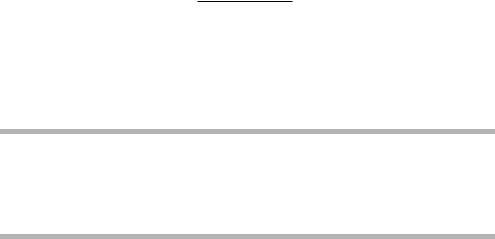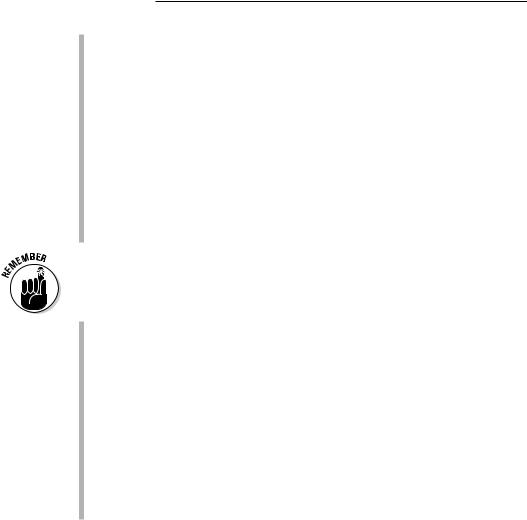
- •About the Authors
- •Dedication
- •Acknowledgments
- •Table of Contents
- •Introduction
- •About This Book
- •Conventions Used in This Book
- •Foolish Assumptions
- •How This Book Is Organized
- •Icons Used in This Book
- •Where to Go from Here
- •The French You’re Familiar With
- •Idioms and Popular Expressions
- •Key Parts of Speech
- •Cavorting with Verbs
- •Forming Sentences and Questions
- •The French Alphabet
- •Uttering Vowel and Consonant Sounds
- •Greetings: Formal and Friendly
- •Asking Questions to Get to Know People
- •Counting Your Lucky Stars: Numbers
- •Using the Calendar and Dates
- •Telling Time in French
- •Discussing Where You Live with the Verb “Habiter”
- •Discussing Daily Routine with Reflexive Verbs
- •Using Possessive Adjectives to Introduce Your Family Members
- •Basic Questions and Polite Expressions
- •Stating Your Preferences
- •Talking about Your Livelihood
- •Chatting about the Weather
- •Deciding to Keep in Touch
- •Getting Direction about Directions
- •Dining Out
- •Going to the Market
- •Going Shopping
- •Going Out with the Verb “Sortir”
- •Having Fun with the Verb “S’amuser”
- •Oh, the Places You’ll Go!
- •Making Plans with Friends
- •Making a Phone Call
- •Livin’ in the Past: Using the Past Tense
- •Playing Sports and Games
- •Going to the Beach
- •Setting Up Camp
- •Enjoying Quieter Pursuits
- •Where Do You Want to Go?
- •Getting Ready for Your Trip
- •Getting Current with Currency
- •Going to the Bank
- •Using Credit Cards and ATMs
- •Getting through the Airport
- •Navigating Buses, Trains, and Subways
- •Getting Around by Car
- •Finding Accommodations
- •Checking In to a Hotel
- •Checking Out of a Hotel
- •Getting Help Fast
- •Getting Medical Help
- •Handling Legal Matters
- •Label the Things in Your House
- •Write Your Shopping Lists in French
- •Listen to French Music
- •Watch French Movies
- •Tune in to TV5
- •Read French Publications
- •Take a Class
- •Join a French Association
- •Join an Online Chat or Pen Pal Forum
- •Using “Tu” When You Mean “Vous”
- •Using “Bonne nuit!” for Good-Bye
- •Using “Garçon” or “Porteur” to Address Service Staff
- •Saying “Je suis excité(e)” to Indicate Excitement
- •Saying “Je suis chaud(e)/froid(e)” to Say You’re Hot or Cold
- •Saying “Je suis plein/e” to Mean You’re Full
- •Using “de la glace” to Request Ice
- •Using “Je suis . . . ans” to Tell Your Age
- •Asking for Change with “J’ai besoin de change”
- •Using the Verb “Visiter” in Reference to People
- •“À mon avis”
- •“C’est pas vrai”
- •“Avec plaisir”
- •“C’est génial”
- •“À votre santé”
- •“À vos souhaits”
- •“Quelle horreur!”
- •“À bientôt”
- •“Passez-moi un coup de fil!”
- •“On y va!” or “Allons-y!”
- •“Je n’en sais rien”
- •“Je n’en reviens pas”
- •“Ça vaut la peine”
- •“C’est pas grave”
- •“N’importe”
- •“Tu cherches midi à 14h”
- •“Prenons un pot!”
- •Regular French Verbs
- •Auxiliary French Verbs
- •Track Listing
- •Customer Care
- •Index

Chapter 4
Getting Your Numbers, Dates,
and Times Straight
In This Chapter
Discovering cardinal and ordinal numbers
Using the calendar and dates
Telling time
Counting and being able to express and understand numbers is an indispensable part of everyday life. You need numbers when you reveal
your age, when you are making the perfect soufflé, or when you’re trying to find your favorite TV program. One of the most important uses of numbers is to tell time. How else can you keep track of appointments or plan trips? In this chapter, we show you how to do all of that — use numbers, dates, and time — one step at a time.
Counting Your Lucky Stars: Numbers
You don’t need to juggle numbers like a mathematician: Most of the time, you can use plain old cardinal numbers from 0 to around 100 to express the number of units of anything: how much money you have in your wallet, how many sheep you have to count before you fall asleep, how many hours you have to wait before your plane takes off, and so on. Fortunately, French numbers follow a pattern, much like numbers in English.
Counting up to 20
The following list shows the numbers un (uhN) (one) through vingt (vaN) (twenty):
www.ATIBOOK.ir

54 |
Part I: Getting Started |
1 un (uhN) |
|
11 onze (ohNz) |
2 deux (duh) |
|
12 douze (doohz) |
3 trois (trwah) |
|
13 treize (trehz) |
4 quatre (kah-truh) |
|
14 quatorze (kah-tohrz) |
5 cinq (saNk) |
|
15 quinze (kaNz) |
6 six (sees) |
|
16 seize (sehz) |
7 sept (seht) |
|
17 dix-sept (dee-seht) |
8 huit (weet) |
|
18 dix-huit (deez-weet) |
9 neuf (nuhf) |
|
19 dix-neuf (deez-nuhf) |
10 dix (dees) |
|
20 vingt (vaN) |
|
The pronunciation of some numbers changes when the number is followed by a vowel, a mute h (check out the mute h in Chapter 3), or a consonant. The following list explains:
When a number ending in –s or –x is followed by a vowel: In these instances, the final s and x make a z sound: deux enfants (duhz- ahN-fahN) (two children) and trois enfants (trwahz-ahN-fahN) (three children), for example.
When the numbers neuf (nuhf) (nine) and dix-neuf (dees-nuhf) (nineteen) are followed by a vowel: In these cases, the final f makes the v sound: neuf artistes (nuhv arh-teest) (nine artists), for example.
When the numbers six (sees) (six), huit (weet) (eight), dix (dees) (ten) are followed by a consonant: The final consonants of these numbers are not pronounced: six livres (see lee-vruh) (six books), huit personnes (wee pehr-sohhn) (eight people), and dix films
(dee feelm) (ten films), for example.
Counting higher
After you count to vingt, you’re ready to go higher. After all, if you want to make a special purchase like an exceptional bottle of wine, for example, it will surely cost more than 20 euros! With what follows, you can handle almost everything number-related.
For numbers 20 through 69
You form the numbers 20 through 69 in French much as you do in English, counting up from each tens number, until you hit the next tens number and then starting over.
www.ATIBOOK.ir

Chapter 4: Getting Your Numbers, Dates, and Times Straight |
55 |
21 vingt et un (vaN-tey-uhN)
22 vingt-deux (vahNt-duh)
23 vingt-trois (vahNt-trwah) and so on
30 trente (trahNt)
31 trente et un (trahN-tey-uhN)
32 trente-deux (trahN-duh) and so on
40 quarante (kah-rahNt)
41 quarante et un (kah-rahN-tey uhN)
42 quarante-deux (kah-rahN-duh) and so on
50 cinquante (saN-kahNt)
51 cinquante et un (saN-kahN-tey uhN)
52 cinquante-deux (saN-kahNt-duh) and so on
60 soixante (swah-sahNt)
61 soixante et un (swah-sahN-tey uhN)
62 soixante-deux (swah-sahNt-duh) and so on
For numbers 70 through 99
The number 70 in French is 60 + 10. The number 71 is 60 + 11, 72 is 60 + 12, and so on until you get to 80. For example:
70 soixante-dix (swah-sahNt-dees)
71 soixante et onze (swah-sahN-tey ohNz)
72 soixantedouze (swah-sahNt-doohz) and so on
The number 80 is 4 × 20, although the word “times” isn’t used. The number 81 is 4 × 20 + 1, 82 is 4 × 20 + 2 and so on, until you get to 90, which is 4 × 20 + 10. The number 91 is 4 × 20 + 11. (Notice that you don’t use the conjunction et in the number 81 and higher. Also when another number follows 80, the s in vingt is dropped.) Here are some examples:
www.ATIBOOK.ir

56 |
Part I: Getting Started |
80 quatre-vingts (kah-truh-vaN)
81 quatre-vingt-un (kah-truh-vaN-uhN)
82 quatre-vingt-deux (kah-truh-vaN-duh) and so on
90 quatre-vingt-dix (kah-truh-vaN-dees)
91 quatre-vingt-onze (kah-truh-vaNt-ohNz)
92 quatre-vingt-douze (kah-truh-vaN-doohz) and so on
If you travel to Switzerland or to Belgium, you may be happy to know that the old — and easier — forms of septante (sehp-tahNt) (70) and nonante (nohnaNt) (90) are commonly used instead of the French soixante-dix and quatre- vingt-dix. Some parts of Switzerland use the forms huitante (wee-tahNt) or octante (ohk-tahNt) for 80.
For the numbers 100 and up
After you hit 100, counting to a thousand or even hundreds of thousands is a breeze. Just indicate the number of hundreds or thousands and count up as you do in English. For example:
100 cent (sahN)
101 cent-un (sahN-uhN)
102 cent-deux (sahN-duh) and so on
200 deux cents (duh sahN)
201 deux cent un (duh sahN uhN)
202 deux cent deux (duh sahN duh) and so on
1,000 mille (meel)
2,000 deux mille (duh meel)
3,000 trois mille (trwah meel) and so on
1,000,000 un million (uhN mee-lyohN)
1,000,000,000 un milliard (uhN mee-lyahr)
In the preceding list, notice that you drop the s in cents when another number follows it. Also, the number mille doesn’t use an s, even when it refers to several thousands. Finally, un does not precede cent or mille when you say one hundred or one thousand.
www.ATIBOOK.ir

Chapter 4: Getting Your Numbers, Dates, and Times Straight |
57 |
Discovering ordinal numbers
Ordinal numbers are important when you need to give or follow directions. (Go to Chapter 7 for info on giving and getting directions in French.) To recognize ordinal numbers, remember that, except for premiere (pruhmyey) (first), they all have –ième (ee-ehm) after the number (just like the -th ending in English). Also, whereas English uses the superscript th (or st or rd) to indicate ordinal numbers (5th, for example), in French, the superscript is the letter e: 9e, 4e, and so on. Table 4-1 lists the ordinal numbers from first through twentieth, but you can go as high as you like. Here are the rules for forming ordinal numbers:
If the cardinal number ends in an –e, the –e is dropped: For example, quatre (kah-truh) (four) becomes quatrième (kah-tree-ehm) (fourth), seize (sehz) (sixteen) becomes seizième (seh-zee-ehm) (sixteenth).
For the number cinq (saNk) (five), add a u before –ième: cinquième (sahN-kee-ehm) (fifth).
For the number 9, neuf (nuhf), the f changes to v: neuvième (nuh-vee- ehm) (ninth).
Table 4-1 |
Ordinal Numbers, from 1er through 20e |
|
|||
Abbrev. |
French |
Pronunciation |
Abbrev. |
French |
Pronunciation |
1e |
premiere |
(pruh-myey) |
11e |
onzième |
(ohN-zee-ehm) |
2e |
deuxième |
(duh-zee-ehm) |
12e |
douzième |
(dooh-zee-ehm) |
3e |
troisième |
(trwah-zee- |
13e |
treizième |
(treh-zee-ehm) |
|
|
ehm) |
|
|
|
4e |
quatrième |
(kah-tree- |
14e |
quatorzième |
(kah-tohr-zee- |
|
|
ehm) |
|
|
ehm) |
|
|
|
|
|
|
5e |
cinquième |
(sahN-kee- |
15e |
quinzième |
(kahN-zee-ehm) |
|
|
ehm) |
|
|
|
6e |
sixième |
(see-zee-ehm) |
16e |
seizième |
(seh-zee-ehm) |
7e |
septième |
(seh-tee-ehm) |
17e |
dix-septième |
(dee-seh-tee- |
|
|
|
|
|
ehm) |
|
|
|
|
|
|
8e |
huitième |
(wee-tee- |
18e |
dix-huitième |
(dee-zwee-tee- |
|
|
ehm) |
|
|
ehm) |
9e |
neuvième |
(nuh-vee- |
19e |
dix-neuvième |
(deez-nuh-vee- |
|
|
ehm) |
|
|
ehm) |
|
|
|
|
|
|
10e |
dixième |
(dee-zee-ehm) |
20e |
vingtième |
(vaN-tee-ehm) |
www.ATIBOOK.ir
